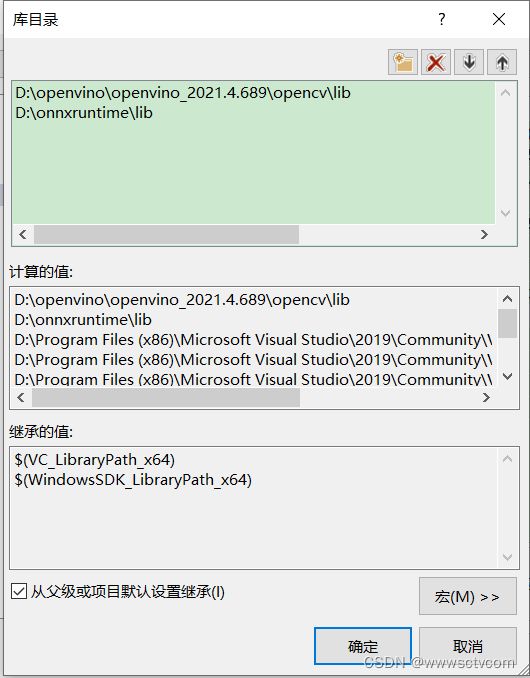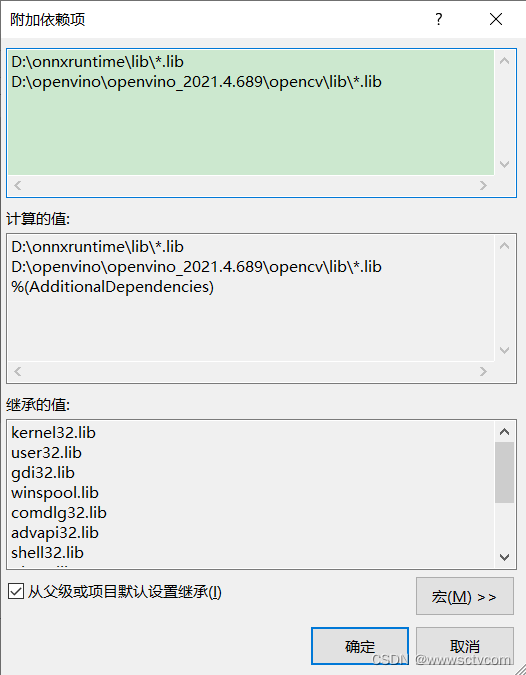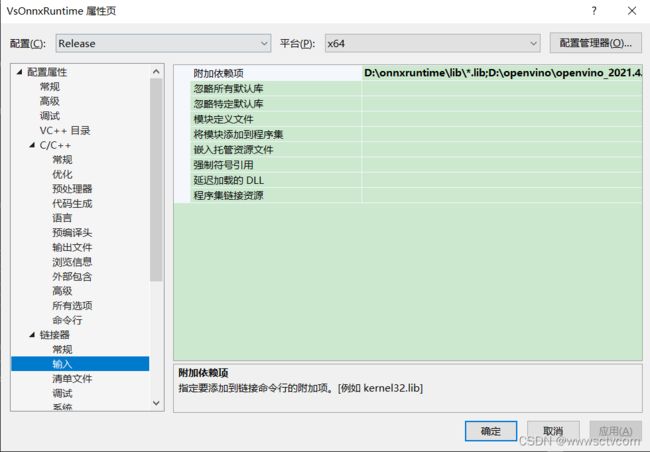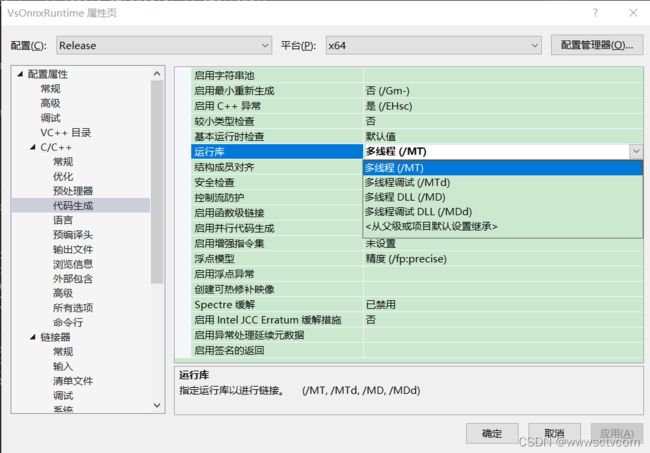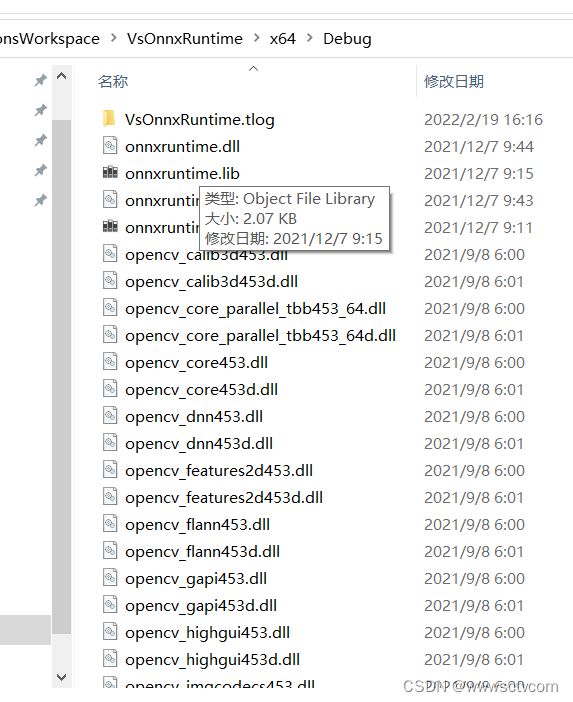VC2019配置Onnxruntime和OpenCV环境
一、环境配置
0、配置Debug或Release模式
1、配置包含目录:
D:\openvino\openvino_2021.4.689\opencv\include和D:\onnxruntime\include
2、设置库目录
D:\onnxruntime\lib和D:\openvino\openvino_2021.4.689\opencv\lib
3、配置附加依赖项:D:\openvino\openvino_2021.4.689\opencv\lib\*.lib和D:\onnxruntime\lib\*.lib
4、Release模式下将默认的,多线程DLL(/MD)修改为多线程(/MT);
Debug模式下将默认的,多线程调试DLL(/MDd) 修改为多线程调试(/MTd);
Note:运行时缺msvcp100d.dll和msvcr100d.dll_槑宝包-CSDN博客_msvcr100d.dll
5、将需要的DLL文件放到D:\ClionsWorkspace\VsOnnxRuntime\x64\Release或者D:\ClionsWorkspace\VsOnnxRuntime\x64\Debug下;
二、源码:
#include
#include
#include
#include
#include
#include
#include
#include
#include
#include
#include
#include
#include
#include // To use runtime_error
template
T vectorProduct(const std::vector& v)
{
return accumulate(v.begin(), v.end(), 1, std::multiplies());
}
/**
* @brief Operator overloading for printing vectors
* @tparam T
* @param os
* @param v
* @return std::ostream&
*/
template
std::ostream& operator<<(std::ostream& os, const std::vector& v)
{
os << "[";
for (int i = 0; i < v.size(); ++i)
{
os << v[i];
if (i != v.size() - 1)
{
os << ", ";
}
}
os << "]";
return os;
}
// Function to validate the input image file extension.
bool imageFileExtension(std::string str)
{
// is empty throw error
if (str.empty())
throw std::runtime_error("[ ERROR ] The image File path is empty");
size_t pos = str.rfind('.');
if (pos == std::string::npos)
return false;
std::string ext = str.substr(pos + 1);
if (ext == "jpg" || ext == "jpeg" || ext == "gif" || ext == "png" || ext == "jfif" ||
ext == "JPG" || ext == "JPEG" || ext == "GIF" || ext == "PNG" || ext == "JFIF") {
return true;
}
return false;
}
// Function to read the labels from the labelFilepath.
std::vector readLabels(std::string& labelFilepath)
{
std::vector labels;
std::string line;
std::ifstream fp(labelFilepath);
while (std::getline(fp, line))
{
labels.push_back(line);
}
return labels;
}
// Function to validate the input model file extension.
bool checkModelExtension(const std::string& filename)
{
if (filename.empty())
{
throw std::runtime_error("[ ERROR ] The Model file path is empty");
}
size_t pos = filename.rfind('.');
if (pos == std::string::npos)
return false;
std::string ext = filename.substr(pos + 1);
if (ext == "onnx")
return true;
return false;
}
// Function to validate the Label file extension.
bool checkLabelFileExtension(const std::string& filename)
{
size_t pos = filename.rfind('.');
if (filename.empty())
{
throw std::runtime_error("[ ERROR ] The Label file path is empty");
}
if (pos == std::string::npos)
return false;
std::string ext = filename.substr(pos + 1);
if (ext == "txt") {
return true;
}
else {
return false;
}
}
//Handling divide by zero
float division(float num, float den) {
if (den == 0) {
throw std::runtime_error("[ ERROR ] Math error: Attempted to divide by Zero\n");
}
return (num / den);
}
void printHelp() {
std::cout << "To run the model, use the following command:\n";
std::cout << "Example: run_squeezenet --use_openvino " << std::endl;
std::cout << "\n To Run using OpenVINO EP.\nExample: run_squeezenet --use_openvino squeezenet1.1-7.onnx demo.jpeg synset.txt \n" << std::endl;
std::cout << "\n To Run on Default CPU.\n Example: run_squeezenet --use_cpu squeezenet1.1-7.onnx demo.jpeg synset.txt \n" << std::endl;
}
int main(int argc, char* argv[])
{
bool useOPENVINO{ true };
const char* useOPENVINOFlag = "--use_openvino";
const char* useCPUFlag = "--use_cpu";
if (argc == 2) {
std::string option = argv[1];
if (option == "--help" || option == "-help" || option == "--h" || option == "-h") {
printHelp();
}
return 0;
}
else if (argc != 5) {
std::cout << "[ ERROR ] you have used the wrong command to run your program." << std::endl;
printHelp();
return 0;
}
else if (strcmp(argv[1], useOPENVINOFlag) == 0) {
useOPENVINO = true;
}
else if (strcmp(argv[1], useCPUFlag) == 0) {
useOPENVINO = false;
}
if (useOPENVINO)
{
std::cout << "Inference Execution Provider: OPENVINO" << std::endl;
}
else
{
std::cout << "Inference Execution Provider: CPU" << std::endl;
}
std::string instanceName{ "image-classification-inference" };
#ifdef _WIN32
std::string str_arg2 = argv[2];
std::wstring wide_string_arg2 = std::wstring(str_arg2.begin(), str_arg2.end());
std::basic_string modelFilepath = std::basic_string(wide_string_arg2);
#else
std::string modelFilepath = argv[2]; // .onnx file
//validate ModelFilePath
checkModelExtension(modelFilepath);
if (!checkModelExtension(modelFilepath)) {
throw std::runtime_error("[ ERROR ] The ModelFilepath is not correct. Make sure you are setting the path to an onnx model file (.onnx)");
}
#endif
std::string imageFilepath = argv[3];
// Validate ImageFilePath
imageFileExtension(imageFilepath);
if (!imageFileExtension(imageFilepath)) {
throw std::runtime_error("[ ERROR ] The imageFilepath doesn't have correct image extension. Choose from jpeg, jpg, gif, png, PNG, jfif");
}
std::ifstream f(imageFilepath.c_str());
if (!f.good()) {
throw std::runtime_error("[ ERROR ] The imageFilepath is not set correctly or doesn't exist");
}
// Validate LabelFilePath
std::string labelFilepath = argv[4];
if (!checkLabelFileExtension(labelFilepath)) {
throw std::runtime_error("[ ERROR ] The LabelFilepath is not set correctly and the labels file should end with extension .txt");
}
std::vector labels{ readLabels(labelFilepath) };
Ort::Env env(OrtLoggingLevel::ORT_LOGGING_LEVEL_WARNING,
instanceName.c_str());
Ort::SessionOptions sessionOptions;
sessionOptions.SetIntraOpNumThreads(1);
//Appending OpenVINO Execution Provider API
if (useOPENVINO) {
// Using OPENVINO backend
OrtOpenVINOProviderOptions options;
options.device_type = "CPU_FP32"; //Other options are: GPU_FP32, GPU_FP16, MYRIAD_FP16
std::cout << "OpenVINO device type is set to: " << options.device_type << std::endl;
sessionOptions.AppendExecutionProvider_OpenVINO(options);
}
// Sets graph optimization level
// Available levels are
// ORT_DISABLE_ALL -> To disable all optimizations
// ORT_ENABLE_BASIC -> To enable basic optimizations (Such as redundant node
// removals) ORT_ENABLE_EXTENDED -> To enable extended optimizations
// (Includes level 1 + more complex optimizations like node fusions)
// ORT_ENABLE_ALL -> To Enable All possible optimizations
sessionOptions.SetGraphOptimizationLevel(
GraphOptimizationLevel::ORT_DISABLE_ALL);
//Creation: The Ort::Session is created here
Ort::Session session(env, modelFilepath.c_str(), sessionOptions);
Ort::AllocatorWithDefaultOptions allocator;
size_t numInputNodes = session.GetInputCount();
size_t numOutputNodes = session.GetOutputCount();
std::cout << "Number of Input Nodes: " << numInputNodes << std::endl;
std::cout << "Number of Output Nodes: " << numOutputNodes << std::endl;
const char* inputName = session.GetInputName(0, allocator);
std::cout << "Input Name: " << inputName << std::endl;
Ort::TypeInfo inputTypeInfo = session.GetInputTypeInfo(0);
auto inputTensorInfo = inputTypeInfo.GetTensorTypeAndShapeInfo();
ONNXTensorElementDataType inputType = inputTensorInfo.GetElementType();
std::cout << "Input Type: " << inputType << std::endl;
std::vector inputDims = inputTensorInfo.GetShape();
std::cout << "Input Dimensions: " << inputDims << std::endl;
const char* outputName = session.GetOutputName(0, allocator);
std::cout << "Output Name: " << outputName << std::endl;
Ort::TypeInfo outputTypeInfo = session.GetOutputTypeInfo(0);
auto outputTensorInfo = outputTypeInfo.GetTensorTypeAndShapeInfo();
ONNXTensorElementDataType outputType = outputTensorInfo.GetElementType();
std::cout << "Output Type: " << outputType << std::endl;
std::vector outputDims = outputTensorInfo.GetShape();
std::cout << "Output Dimensions: " << outputDims << std::endl;
//pre-processing the Image
// step 1: Read an image in HWC BGR UINT8 format.
cv::Mat imageBGR = cv::imread(imageFilepath, cv::ImreadModes::IMREAD_COLOR);
// step 2: Resize the image.
cv::Mat resizedImageBGR, resizedImageRGB, resizedImage, preprocessedImage;
cv::resize(imageBGR, resizedImageBGR,
cv::Size(inputDims.at(2), inputDims.at(3)),
cv::InterpolationFlags::INTER_CUBIC);
// step 3: Convert the image to HWC RGB UINT8 format.
cv::cvtColor(resizedImageBGR, resizedImageRGB,
cv::ColorConversionCodes::COLOR_BGR2RGB);
// step 4: Convert the image to HWC RGB float format by dividing each pixel by 255.
resizedImageRGB.convertTo(resizedImage, CV_32F, 1.0 / 255);
// step 5: Split the RGB channels from the image.
cv::Mat channels[3];
cv::split(resizedImage, channels);
//step 6: Normalize each channel.
// Normalization per channel
// Normalization parameters obtained from
// https://github.com/onnx/models/tree/master/vision/classification/squeezenet
channels[0] = (channels[0] - 0.485) / 0.229;
channels[1] = (channels[1] - 0.456) / 0.224;
channels[2] = (channels[2] - 0.406) / 0.225;
//step 7: Merge the RGB channels back to the image.
cv::merge(channels, 3, resizedImage);
// step 8: Convert the image to CHW RGB float format.
// HWC to CHW
cv::dnn::blobFromImage(resizedImage, preprocessedImage);
//Run Inference
/* To run inference using ONNX Runtime, the user is responsible for creating and managing the
input and output buffers. These buffers could be created and managed via std::vector.
The linear-format input data should be copied to the buffer for ONNX Runtime inference. */
size_t inputTensorSize = vectorProduct(inputDims);
std::vector inputTensorValues(inputTensorSize);
inputTensorValues.assign(preprocessedImage.begin(),
preprocessedImage.end());
size_t outputTensorSize = vectorProduct(outputDims);
assert(("Output tensor size should equal to the label set size.",
labels.size() == outputTensorSize));
std::vector outputTensorValues(outputTensorSize);
/* Once the buffers were created, they would be used for creating instances of Ort::Value
which is the tensor format for ONNX Runtime. There could be multiple inputs for a neural network,
so we have to prepare an array of Ort::Value instances for inputs and outputs respectively even if
we only have one input and one output. */
std::vector inputNames{ inputName };
std::vector outputNames{ outputName };
std::vector inputTensors;
std::vector outputTensors;
/*
Creating ONNX Runtime inference sessions, querying input and output names,
dimensions, and types are trivial.
Setup inputs & outputs: The input & output tensors are created here. */
Ort::MemoryInfo memoryInfo = Ort::MemoryInfo::CreateCpu(
OrtAllocatorType::OrtArenaAllocator, OrtMemType::OrtMemTypeDefault);
inputTensors.push_back(Ort::Value::CreateTensor(
memoryInfo, inputTensorValues.data(), inputTensorSize, inputDims.data(),
inputDims.size()));
outputTensors.push_back(Ort::Value::CreateTensor(
memoryInfo, outputTensorValues.data(), outputTensorSize,
outputDims.data(), outputDims.size()));
/* To run inference, we provide the run options, an array of input names corresponding to the
inputs in the input tensor, an array of input tensor, number of inputs, an array of output names
corresponding to the the outputs in the output tensor, an array of output tensor, number of outputs. */
session.Run(Ort::RunOptions{ nullptr }, inputNames.data(),
inputTensors.data(), 1, outputNames.data(),
outputTensors.data(), 1);
int predId = 0;
float activation = 0;
float maxActivation = std::numeric_limits::lowest();
float expSum = 0;
/* The inference result could be found in the buffer for the output tensors,
which are usually the buffer from std::vector instances. */
for (int i = 0; i < labels.size(); i++) {
activation = outputTensorValues.at(i);
expSum += std::exp(activation);
if (activation > maxActivation)
{
predId = i;
maxActivation = activation;
}
}
std::cout << "Predicted Label ID: " << predId << std::endl;
std::cout << "Predicted Label: " << labels.at(predId) << std::endl;
float result;
try {
result = division(std::exp(maxActivation), expSum);
std::cout << "Uncalibrated Confidence: " << result << std::endl;
}
catch (std::runtime_error& e) {
std::cout << "Exception occurred" << std::endl << e.what();
}
// Measure latency
int numTests{ 100 };
std::chrono::steady_clock::time_point begin =
std::chrono::steady_clock::now();
//Run: Running the session is done in the Run() method:
for (int i = 0; i < numTests; i++) {
session.Run(Ort::RunOptions{ nullptr }, inputNames.data(),
inputTensors.data(), 1, outputNames.data(),
outputTensors.data(), 1);
}
std::chrono::steady_clock::time_point end =
std::chrono::steady_clock::now();
std::cout << "Minimum Inference Latency: "
<< std::chrono::duration_cast(end - begin).count() / static_cast(numTests)
<< " ms" << std::endl;
return 0;
} 

